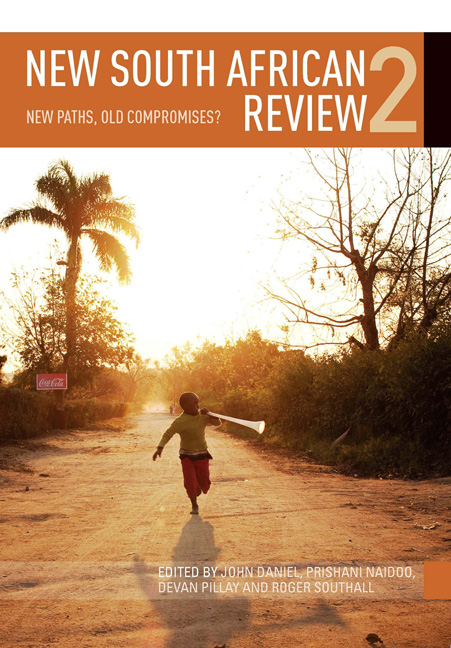Book contents
- Frontmatter
- Contents
- Preface
- Introduction: New paths, old (com)promises?
- PART 1 POLITICS AND INTERNATIONAL
- PART 2 ECONOMY AND SOCIETY
- PART 3 ENVIRONMENT
- Introduction: Ecological threats and the crisis of civilisation
- Chapter 14 Above and beyond South Africa's minerals-energy complex
- Chapter 15 Corrosion and externalities: The socio-economic impacts of acid mine drainage on the Witwatersrand
- Chapter 16 Food versus fuel? State, business, civil society and the bio-fuels debate in South Africa, 2003 to 2010
- PART 4 MEDIA
- Contributors
- Index
Chapter 14 - Above and beyond South Africa's minerals-energy complex
from PART 3 - ENVIRONMENT
Published online by Cambridge University Press: 23 March 2018
- Frontmatter
- Contents
- Preface
- Introduction: New paths, old (com)promises?
- PART 1 POLITICS AND INTERNATIONAL
- PART 2 ECONOMY AND SOCIETY
- PART 3 ENVIRONMENT
- Introduction: Ecological threats and the crisis of civilisation
- Chapter 14 Above and beyond South Africa's minerals-energy complex
- Chapter 15 Corrosion and externalities: The socio-economic impacts of acid mine drainage on the Witwatersrand
- Chapter 16 Food versus fuel? State, business, civil society and the bio-fuels debate in South Africa, 2003 to 2010
- PART 4 MEDIA
- Contributors
- Index
Summary
INTRODUCTION
The South African minerals-energy complex is now widely understood as a barrier to the society's balanced development and also a threat of great magnitude to the local and global environment. By early 2011, with a New Growth Path (NGP) document stressing a green economy, a Green Paper on climate, and a new national energy plan under debate, and following the March 2011 meltdown of a Japanese nuclear power plant, a great many potential routes opened up for sensible policy changes. However, the inherited legacies of apartheid-era and post-apartheid ‘developmental state’ projects have made a U-turn extremely difficult.
Dating back to the discovery of Kimberley diamonds in the 1860s and Witwatersrand gold in the 1880s, a handful of corporations gained power over South Africa's development policy. At one point, Anglo American and De Beers – run mainly by the Oppenheimer family dynasty – controlled almost half the country's gold and platinum, a quarter of its coal, and virtually all its diamonds, and held critical stakes in banking, steel, auto, electronics, agriculture and many other industries. The Truth and Reconciliation Commission determined after the 1996 hearings that the South African mining industry's ‘direct involvement with the state in the formulation of oppressive policies or practices that resulted in low labour costs (or otherwise boosted profits) can be described as first-order involvement [in apartheid] … The shameful history of subhuman compound [hostel] conditions, brutal suppression of striking workers, racist practices and meagre wages is central to understanding the origins and nature of apartheid’ (TRC, 1998: 34).
By the 1980s, however, South Africa's internal accumulation crisis – brought on by social resistance as well as internal contradictions in the capitalist system (Bond, 2006) – began to compel both political and economic changes. As the chairman of Anglo, Harry Oppenheimer, stated, in 1985: ‘Nationalist policies have made it impossible to make proper use of black labour’ (cited in Sharife, 2010c). The result, from 1994, was a ‘liberated’ nation accurately described by Ali Mazrui in a speech in Cape Town where he stated of the thriving legacy: ‘You were the crown, we'll keep the jewels’, referring to black political domination – the crown of the state – and white control of intellectual, economic and other ‘jewels’ (Mazrui, 1998).
- Type
- Chapter
- Information
- New South African Review 2New paths, old compromises?, pp. 279 - 299Publisher: Wits University PressPrint publication year: 2012



